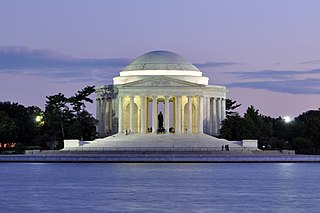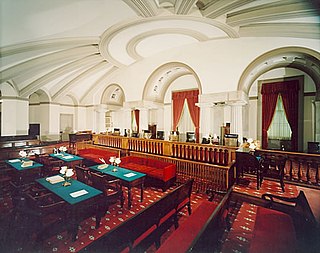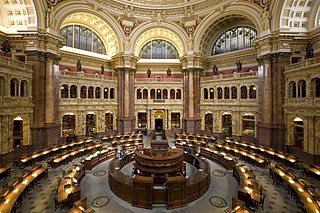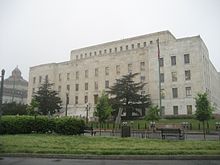
The United States Capitol, often called The Capitol or the Capitol Building, is the seat of the United States Congress, the legislative branch of the federal government. It is located on Capitol Hill at the eastern end of the National Mall in Washington, D.C. Although no longer at the geographic center of the federal district, the Capitol forms the origin point for the street-numbering system of the district as well as its four quadrants.

Lee Oscar Lawrie was an American architectural sculptor and a key figure in the American art scene preceding World War II. Over his long career of more than 300 commissions Lawrie's style evolved through Modern Gothic, to Beaux-Arts, Classicism, and, finally, into Moderne or Art Deco.

The Jefferson Memorial is a presidential memorial built in Washington, D.C., between 1939 and 1943 in honor of Thomas Jefferson, the principal author of the United States Declaration of Independence, a central intellectual force behind the American Revolution, founder of the Democratic-Republican Party, and the nation's third president.

The librarian of Congress is the head of the Library of Congress, appointed by the president of the United States with the advice and consent of the United States Senate, for a term of ten years. The librarian of Congress also appoints and oversees the Register of Copyrights of the U.S. Copyright Office and has broad responsibilities around copyright, extending to electronic resources and fair use provisions outlined in the Digital Millennium Copyright Act. The librarian determines whether particular works are subject to DMCA prohibitions regarding technological access protection. In addition, the librarian appoints the U.S. poet laureate and awards the Gershwin Prize for Popular Song.

George Watterston was the third Librarian of the United States Congress from 1815 to 1829.

Patrick Magruder was an American lawyer, politician, and librarian who served as a Member of the U.S. House of Representatives from Maryland’s 3rd congressional District from March 4, 1805, to March 3, 1807, and as the 2nd Librarian of the United States Congress, from December 26, 1807, to January 18, 1815.

Scene at the Signing of the Constitution of the United States is a 1940 oil-on-canvas painting by Howard Chandler Christy, depicting the Constitutional Convention signing the U.S. Constitution at Independence Hall in Philadelphia on September 17, 1787. Along with Washington Crossing the Delaware by Emanuel Leutze, the painting is one of the most famous depictions of the early days of the United States. Christy created the painting in April 1940; it is so large that he painted it in a sail loft. It currently is displayed along the east stairway in the House of Representatives wing in the Capitol building.

The Residence Act of 1790, officially titled An Act for establishing the temporary and permanent seat of the Government of the United States, is a United States federal statute adopted during the second session of the 1st United States Congress and signed into law by President George Washington on July 16, 1790. The Act provides for a national capital and permanent seat of government to be established at a site along the Potomac River and empowered President Washington to appoint commissioners to oversee the project. It also set a deadline of December 1800 for the capital to be ready, and designated Philadelphia as the nation's temporary capital while the new seat of government was being built. At the time, the federal government operated out of New York City.

Charles Henry Niehaus was an American sculptor.

The United States Capitol Complex is a group of twenty buildings and facilities in Washington, D.C., that are used by the federal government of the United States. The buildings and grounds within the complex are managed and supervised by the architect of the Capitol.

The James Madison Memorial Building is one of three United States Capitol Complex buildings that house the Library of Congress. The building was constructed from 1971 to 1976, and serves as the official memorial to United States Founding Father and president James Madison. It is located between First and Second Streets SE on Independence Avenue, across for the main library Thomas Jefferson Building, in Washington, D.C. In addition to various book and multimedia collections, it houses the United States Copyright Office, which is under the administration of the Librarian of Congress.

The Thomas Jefferson Building, also known as the Main Library, is the oldest of the Library of Congress buildings in Washington, D.C. Built between 1890 and 1897, it was initially known as the Library of Congress Building. In 1980, the building was named in honor of Thomas Jefferson, a Founding Father, the principal author of the Declaration of Independence, and the third U.S. president. In 1815, Jefferson's donation of his own book collection formed a core foundation for the library's collection.
The United States Senate Library is the official library of the United States Senate. While the Library informally began in 1792, it was officially established in 1871 and today holds an estimated 220,000 volumes.

The Old Supreme Court Chamber is the room on the ground floor of the North Wing of the United States Capitol. From 1800 to 1806, the room was the lower half of the first United States Senate chamber, and from 1810 to 1860, the courtroom for the Supreme Court of the United States.

The Library of Congress (LOC) is a research library in Washington, D.C., that serves as the library and research service of the U.S. Congress and the de facto national library of the United States. Founded in 1800, the library is the United States's oldest federal cultural institution. The library is housed in three elaborate buildings on Capitol Hill. It also maintains a conservation center in Culpeper, Virginia. The library's functions are overseen by the librarian of Congress, and its buildings are maintained by the Architect of the Capitol. The Library of Congress is one of the largest libraries in the world. Its collections contain approximately 173 million items, and it has more than 3,000 employees. Its "collections are universal, not limited by subject, format, or national boundary, and include research materials from all parts of the world and in more than 470 languages."

The first inauguration of Thomas Jefferson as the third president of the United States was held on Wednesday, March 4, 1801. The inauguration marked the commencement of the first four-year term of Thomas Jefferson as president and the only four-year term of Aaron Burr as vice president. Jefferson was sworn in by Supreme Court Chief Justice John Marshall.
The Columbian Institute for the Promotion of Arts and Sciences (1816–1838) was a literary and science institution in Washington, D.C., founded by Dr. Edward Cutbush (1772–1843), a naval surgeon. Thomas Law had earlier suggested of such a society "at the seat of government." It was the first "learned society" established in Washington and was organized on June 28, 1816, sixteen years after the city was occupied, and less than two years after the invasion by the British troops. The second article of its constitution states: "The Institute shall consist of mathematical, physical, moral and political sciences, general literature and fine arts."

The Congressional Prayer Room near the rotunda in the United States Capitol is a place set aside for the use of members of Congress who seek a quiet place for meditation or prayer. The space is not open to tour groups or visitors to the Capitol.
Ermelindo Eduardo Ardolino, known as Edward Ardolino was an Italian-born American stone carver and architectural sculptor of the early twentieth century. He was the most prominent member of the Ardolino family of stone carvers. He worked with leading architects and sculptors, including architect Bertram Grosvenor Goodhue and sculptor Lee Lawrie. Ardolino participated in at least nine Goodhue-Lawrie collaborations including the Los Angeles Public Library and the Nebraska State Capitol. His carvings adorn a significant number of important public and private buildings and monuments, including four buildings in the Federal Triangle of Washington, D.C.

The Washington Glass School was founded in 2001 by Washington, DC area artists Tim Tate and Erwin Timmers.























